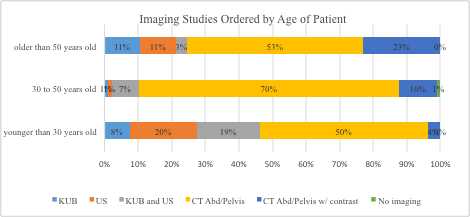
|
Back to 2015 Joint Annual Meeting An Emergency Department’s Adherence to Guidelines for the Evaluation and Management of Nephrolithiasis Jessica Jackson, Karen Wheeler, Jack Farhi, Richard Rueb, Chris Thomas, Noah Schenkman University of Virginia, Charlottesville, VA
Introduction:Recent publications showed significant variation in national practice patterns for the management of nephrolithiasis in the emergency department (ED). The American Urological Association (AUA) and the American Academy of Family Physicians (AAFP) have published guidelines for nephrolithiasis. This study assessed a single institution’s ED adherence to these guidelines.
 Conclusion: Guideline driven evaluation for nephrolithiasis would warrant inclusion of urine analysis and urine culture more frequently in the ED. KUB is an underused modality in this study as both guidelines advocate use for recurrent stone formers. Although, variations in imaging modality for patients at the extremes of age may be due to a wider differential, tighter compliance to non-contrast CT use in the middle aged cohort may represent an area for improvement. Finally MET should be prescribed to a majority of patients with acute renal colic and antibiotics should be given only after urine culture obtained. Implementation of ED specific protocols would provide more effective evaluation and management of renal colic. Back to 2015 Joint Annual Meeting |
||||||||||||||||||||||||||||||||||||||||||||||||||||||||||||||||||||||||||||||||||||||||||||||||||